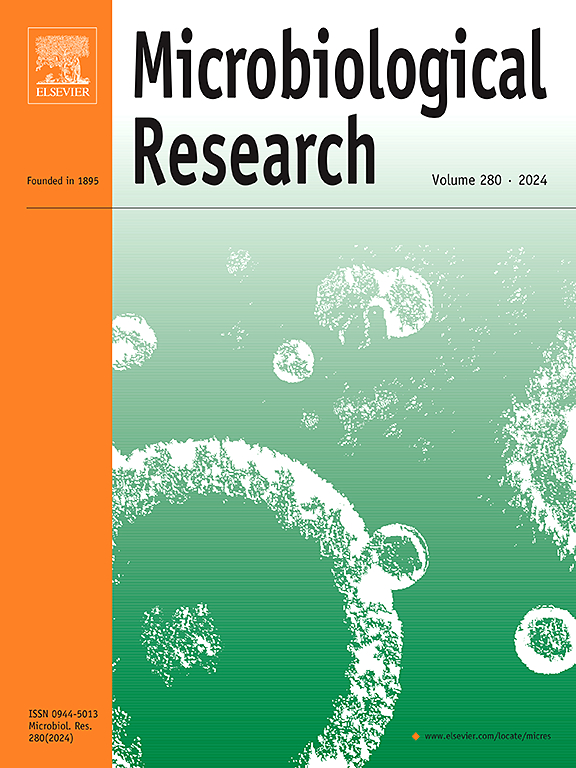C28-aldehyde (n-octacosanal) modulates stage-specific temporal expression of effector genes in the wheat powdery mildew fungus
IF 6.9
1区 生物学
Q1 MICROBIOLOGY
引用次数: 0
Abstract
The prepenetration processes of the wheat powdery mildew fungus, Blumeria graminis f. sp. tritici (Bgt), are triggered by C28 aldehyde (n-octacosanal), a component of cuticular waxes. Despite being the most severe crop disease worldwide, the underlying molecular mechanisms of the prepenetration processes remain obscure. Utilizing a Formvar®-based in vitro system, transcriptomes of Bgt conidia impacted by n-octacosanal were profiled without the effects from plant host. A total of 1354 differentially expressed genes were identified between n-octacosanal- and n-octacosane (non-chemical signal)-treated conidia. The expression of effectors, transcription factors, and HOG-MAPK pathways is specifically regulated by n-octacosanal in a developmental stage-dependent manner. Among them, 25 effectors and three transcription factors, including COD 1, VEA, and CreA, were highly expressed at all stages. While some genes of the HOG-MAPK pathway were significantly upregulated during conidial growth, other genes were downregulated. These results revealed that C28 aldehyde-triggered Bgt conidial prepenetration in the plant host might be achieved by activating specific transcription factors and differentially regulating the HOG-MAPK pathway. The genes detected by our gene expression analysis may be crucial for successful infection by Bgt and thus serve as candidates for future functional analysis of the molecular mechanisms of conidia development in powdery mildew. These findings provide new insights into the chemical-signal-orchestrated development of an important phytopathogenic fungus and will potentially support efforts for the control and management of fungal diseases in wheat.
c28 -醛调节小麦白粉病真菌中效应基因的阶段性时间表达
小麦白粉病真菌Blumeria graminis f. sp. tritici (Bgt)的预渗透过程是由表皮蜡成分C28醛(n-octacosanal)触发的。尽管是世界上最严重的作物病害,但预渗透过程的潜在分子机制仍然不清楚。利用基于Formvar®的离体系统,研究了在不受植物寄主影响的情况下,n-octacosanal对Bgt分生孢子的转录组的影响。共鉴定出1354个差异表达基因在正八糖烷和正八糖烷(非化学信号)处理的分生孢子中。效应物、转录因子和HOG-MAPK通路的表达受n- octacanal以发育阶段依赖的方式特异性调节。其中25个效应物和3个转录因子COD 1、VEA、CreA在各阶段均高表达。HOG-MAPK通路的一些基因在分生孢子生长过程中显著上调,而其他基因则下调。这些结果表明,C28醛触发的Bgt分生孢子在植物寄主体内的预渗透可能是通过激活特异性转录因子和差异调节HOG-MAPK通路来实现的。我们的基因表达分析检测到的基因可能是Bgt成功感染的关键基因,因此可以作为未来白粉病分生孢子发育分子机制功能分析的候选基因。这些发现为一种重要的植物致病真菌的化学信号调控发展提供了新的见解,并将潜在地支持小麦真菌病的控制和管理。
本文章由计算机程序翻译,如有差异,请以英文原文为准。
求助全文
约1分钟内获得全文
求助全文
来源期刊

Microbiological research
生物-微生物学
CiteScore
10.90
自引率
6.00%
发文量
249
审稿时长
29 days
期刊介绍:
Microbiological Research is devoted to publishing reports on prokaryotic and eukaryotic microorganisms such as yeasts, fungi, bacteria, archaea, and protozoa. Research on interactions between pathogenic microorganisms and their environment or hosts are also covered.
 求助内容:
求助内容: 应助结果提醒方式:
应助结果提醒方式:


